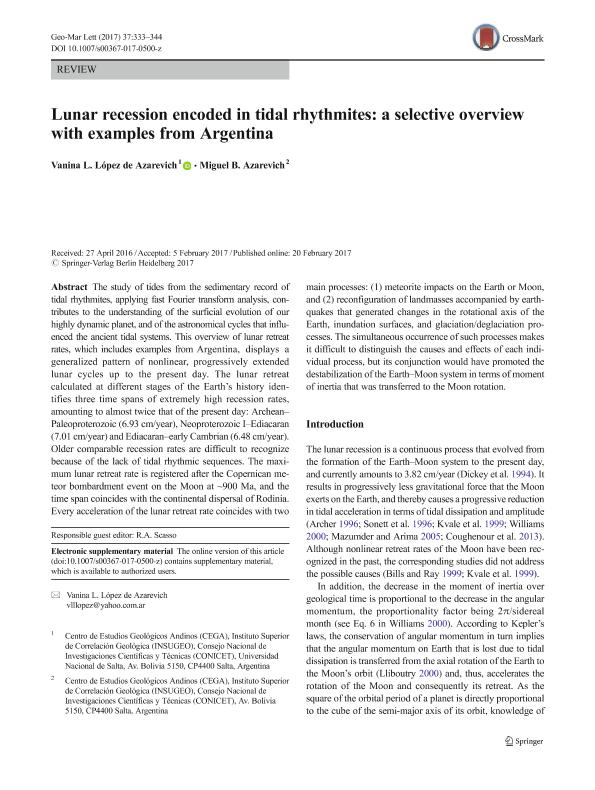Artículo
Lunar recession encoded in tidal rhythmites: a selective overview with examples from Argentina
Fecha de publicación:
08/2017
Editorial:
Springer
Revista:
Geo-marine Letters
ISSN:
0276-0460
Idioma:
Inglés
Tipo de recurso:
Artículo publicado
Clasificación temática:
Resumen
The study of tides from the sedimentary record of tidal rhythmites, applying fast Fourier transform analysis, contributes to the understanding of the surficial evolution of our highly dynamic planet, and of the astronomical cycles that influenced the ancient tidal systems. This overview of lunar retreat rates, which includes examples from Argentina, displays a generalized pattern of nonlinear, progressively extended lunar cycles up to the present day. The lunar retreat calculated at different stages of the Earth’s history identifies three time spans of extremely high recession rates, amounting to almost twice that of the present day: Archean–Paleoproterozoic (6.93 cm/year), Neoproterozoic I–Ediacaran (7.01 cm/year) and Ediacaran–early Cambrian (6.48 cm/year). Older comparable recession rates are difficult to recognize because of the lack of tidal rhythmic sequences. The maximum lunar retreat rate is registered after the Copernican meteor bombardment event on the Moon at ~900 Ma, and the time span coincides with the continental dispersal of Rodinia. Every acceleration of the lunar retreat rate coincides with two main processes: (1) meteorite impacts on the Earth or Moon, and (2) reconfiguration of landmasses accompanied by earthquakes that generated changes in the rotational axis of the Earth, inundation surfaces, and glaciation/deglaciation processes. The simultaneous occurrence of such processes makes it difficult to distinguish the causes and effects of each individual process, but its conjunction would have promoted the destabilization of the Earth–Moon system in terms of moment of inertia that was transferred to the Moon rotation.
Palabras clave:
Lunar
,
Puncovisacana
,
Tidalites
,
Argentina
Archivos asociados
Licencia
Identificadores
Colecciones
Articulos(CCT - NOA SUR)
Articulos de CTRO.CIENTIFICO TECNOL.CONICET - NOA SUR
Articulos de CTRO.CIENTIFICO TECNOL.CONICET - NOA SUR
Citación
López, Vanina Lucrecia; Azarevich, Miguel Basilio; Lunar recession encoded in tidal rhythmites: a selective overview with examples from Argentina; Springer; Geo-marine Letters; 37; 4; 8-2017; 333-344
Compartir
Altmétricas




